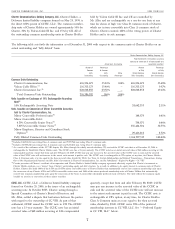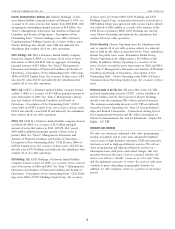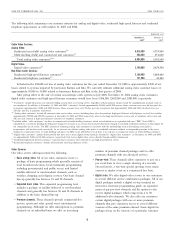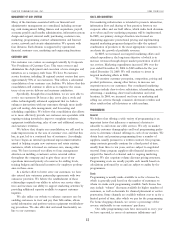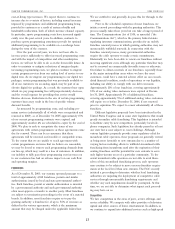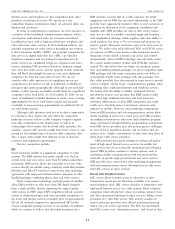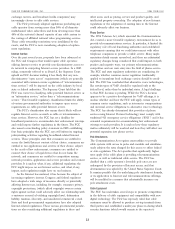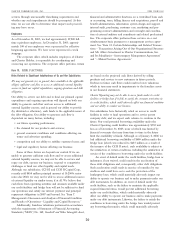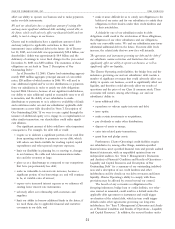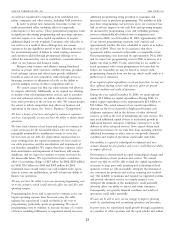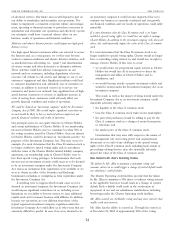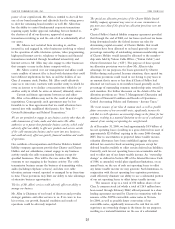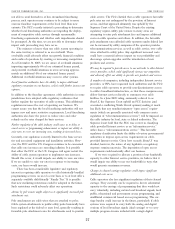Charter 2005 Annual Report Download - page 27
Download and view the complete annual report
Please find page 27 of the 2005 Charter annual report below. You can navigate through the pages in the report by either clicking on the pages listed below, or by using the keyword search tool below to find specific information within the annual report.
CHARTER COMMUNICATIONS, INC. 2005 FORM 10-K
can provide no assurance that the already extensive regulation each television station (dual carriage), as the broadcast industry
of our business will not be expanded in the future. transitions from an analog to a digital format.
The burden could also increase significantly if cable systems
Cable Rate Regulation become required to carry multiple program streams included
The cable industry has operated under a federal rate regulation within a single digital broadcast transmission (multicast car-
regime for more than a decade. The regulations currently riage). Additional government-mandated broadcast carriage obli-
restrict the prices that cable systems charge for the minimum gations could disrupt existing programming commitments,
level of video programming service, referred to as ‘‘basic interfere with our preferred use of limited channel capacity and
service’’, and associated equipment. All other cable offerings are limit our ability to offer services that would maximize customer
now universally exempt from rate regulation. Although basic appeal and revenue potential. Although the FCC issued a
rate regulation operates pursuant to a federal formula, local decision in 2005 confirming an earlier ruling against mandating
governments, commonly referred to as local franchising authori- either dual carriage or multicast carriage, that decision has been
ties, are primarily responsible for administering this regulation. appealed. In addition, the FCC could reverse its own ruling or
The majority of our local franchising authorities have never Congress could legislate additional carriage obligations. The
been certified to regulate basic cable rates, but they retain the President has signed into law legislation establishing February
right to do so (and order rate reductions and refunds), except in 2009 as the deadline to complete the broadcast transition to
those specific communities facing ‘‘effective competition,’’ as digital spectrum and to reclaim analog spectrum. Cable opera-
defined under federal law. With increased DBS competition, our tors may need to take additional operational steps at that time
systems are increasingly likely to satisfy the effective competition to ensure that customers not otherwise equipped to receive
standard. We have already secured FCC recognition of effective digital programming, retain access to broadcast programming.
competition, and been rate deregulated, in many of our
communities. Access Channels
There have been frequent calls to impose expanded rate Local franchise agreements often require cable operators to set
regulation on the cable industry. Confronted with rapidly aside certain channels for public, educational and governmental
increasing cable programming costs, it is possible that Congress access programming. Federal law also requires cable systems to
may adopt new constraints on the retail pricing or packaging of designate a portion of their channel capacity for commercial
cable programming. For example, there has been considerable leased access by unaffiliated third parties. Increased activity in
legislative and regulatory interest in requiring cable offers to this area could further burden the channel capacity of our cable
offer historically bundled programming services on an a la carte systems.
basis or to at least offer a separately available child-friendly Access to Programming
‘‘Family Tier.’’ Such constraints could adversely affect our The Communications Act and the FCC’s ‘‘program access’’ rules
operations. generally prevent satellite video programmers affiliated with
Federal rate regulations generally require cable operators to cable operators from favoring cable operators over competing
allow subscribers to purchase premium or pay-per-view services multichannel video distributors, such as DBS, and limit the
without the necessity of subscribing to any tier of service, other ability of such programmers to offer exclusive programming
than the basic service tier. The applicability of this rule in arrangements to cable operators. The FCC has extended the
certain situations remains unclear, and adverse decisions by the exclusivity restrictions through October 2007. Given the height-
FCC could affect our pricing and packaging of services. As we ened competition and media consolidation that Charter faces, it
attempt to respond to a changing marketplace with competitive is possible that we will find it increasingly difficult to gain access
pricing practices, such as targeted promotions and discounts, we to popular programming at favorable terms. Such difficulty
may face additional legal restraints and challenges that impede could adversely impact our business.
our ability to compete.
Ownership Restrictions
Must Carry/Retransmission Consent Federal regulation of the communications field traditionally
There are two alternative legal methods for carriage of local included a host of ownership restrictions, which limited the size
broadcast television stations on cable systems. Federal law of certain media entities and restricted their ability to enter into
currently includes ‘‘must carry’’ regulations, which require cable competing enterprises. Through a series of legislative, regulatory,
systems to carry certain local broadcast television stations that and judicial actions, most of these restrictions recently were
the cable operator would not select voluntarily. Alternatively, eliminated or substantially relaxed. For example, historic restric-
federal law includes ‘‘retransmission consent’’ regulations, by tions on local exchange carriers offering cable service within
which popular commercial television stations can prohibit cable their telephone service area, as well as those prohibiting
carriage unless the cable operator first negotiates for ‘‘retransmis- broadcast stations from owning cable systems within their
sion consent,’’ which may be conditioned on significant pay- broadcast service area, no longer exist. Changes in this
ments or other concessions. Either option has a potentially regulatory area, including some still subject to judicial review,
adverse effect on our business. The burden associated with must could alter the business landscape in which we operate, as
carry could increase significantly if cable systems were required formidable new competitors (including electric utilities, local
to simultaneously carry both the analog and digital signals of
17


